May River Golf Club
South Carolina, USA
Green Keeper: Chris Johnson

The easy walking Jack Nicklaus design at May River Golf Club takes full advantage of its Lowcountry setting. Beyond the seventh green is the Greenleaf slough, an inlet of the May River.
Jack Nicklaus Design has built over 300 courses in thirty-seven countries. From Gleneagles in Scotland, across to Europe and Asia, down to Australia, up and over to Hawaii, the Baja region of Mexico, and north along the Pacific coast to Whistler in Canada, the geographic reach of Jack Nicklaus’s golf course architecture career is unparalleled.
A huge business today, his design career started quietly enough in the 1960s at first The Golf Club outside of his home town of Columbus, Ohio and then on Hilton Head Island in South Carolina. There, he enjoyed learning and exchanging ideas with Pete Dye during the construction process of Harbour Town.
During the thirty five period from when Harbour Town opened until construction started on May River in 2002, numerous golf architecture trends came and went. Nicklaus’s own thoughts on golf course design evolved as well. What he liked early in his design career, he may no longer care as much for today. For instance, the 1996 Australian Open was held at The Australian Golf Club outside of Sydney. Nicklaus remodeled the course in 1978 as a favor to his friend and member Kerry Packer. Nicklaus told the press after touring the course in 1996 that there was quite a bit he would do different design wise today if given the chance. This caused quite a kafuffle with the membership but the joy of being Jack Nicklaus is that you are always free to speak your mind! Without doubt, The Australian makes for a rigorous test for the game’s best. However, its water hazards and steep faced bunkers that line the edges of the greens limit its lasting appeal to strong golfers only – and Nicklaus realized that.
In general, such high demand architecture characterized golf course construction during the1970s and 1980s. With penal hazards flush against the greens, the golf played on such courses made for dramatic moments when seen on television. However, on a daily playing basis, no golfer enjoys losing several golf balls as it robs him of any sense of playing satisfaction. Playing these designs wore out golfers as they tired of so many do or die shots.
Starting in the 1990s and certainly by 2000, it was evident that something needed to change in golf course architecture. Building a tough golf course was easy. In fact, doing so required little imagination or skill. The far greater challenge was for golf architects to once again build courses that remained interesting to play for a wide range of playing abilities for decades to come a la the courses built during the Golden Age of golf architecture.
Today, every architect claims they build such courses – whether they do or not is a point of debate. To fulfill this lofty claim, what are the key design tenets that must be present?
Certainly, there must be plenty of playing room off the tee. Cramped holes lack strategy, produce cramped swings, and fail to hold the golfer’s interest over time. Angles of play help the course remain engaging for years to come. After encouraging the golfer to make a bold positive swing from the tee, the challenge can stiffen the closer one gets to the green. As most golfers are going to miss more than half the greens during their round, they need to be given the ability to find their ball (i.e. minimal water hazards and thick grass) and have a reasonable opportunity to play a recovery shot (i.e. no twelve feet deep bunkers) in order to enjoy their round. Playing recovery shots from short grass to a green a few feet above the golfer is within the skill set of all golfers and provides the widest range possible in types of recovery shots. Furthermore, when taken together, the eighteen putting surfaces and their interior contours need to pose a variety of challenges. Some should gather balls in toward certain hole locations while others should feature plateaus with shoulders that carry balls away. Finally, the entire course must be reflective of its natural environment. Human beings have a natural affinity for being in nature. Its draw is timeless and if the course’s appeal is rooted in nature, the course too stands a great chance of sharing that timeless quality.
Each of the above desirable traits can be found at May River. This is no surprise as in recent years, Nickalus has spoken openly about the need to return to fun golf. His designs are now reflecting that desire. Mayacama Golf Club in Napa Valley, which opened in August, 2001, is one example and May River is an even better one.
Two common denominators between the two projects is that the lead design associate for the Jack Nicklaus Design was Jim Lipe and the design coordinator was Kurt Bowman. On site daily, Bowman has gone on to become a design associate living and working for Jack Nicklaus Design in Cabo, Mexico. Lipe first joined the Jack Nicklaus organization twenty-four years ago for their course in Cornwall, England. Lipe speaks with great affection for what they accomplished at May River. In particular, the eighteen holes take the golfer on a lovely stroll through the Lowcountry, past numerous specimen three hundred year old live oaks that are found within this Maritime-of-the-Sea forest. According to Lipe, ‘There was never any discussion of moving much dirt on this project. To do so against such a backdrop of mature trees would have only introduced an unwelcome artificial element.’ Various wetlands are crossed but none encroach too much into play. The Greenleaf slough is encountered on the front whereas the course rubs up twice against the May River on the back.
Indeed, the design at May River captures the natural appeal of the site while providing fun and challenging golf for all as well as any Jack Nicklaus course with which the author is familiar. A review of the holes below highlight the various design elements that make it so but a lot of the challenge of May River occurs thirty yards and in to the greens.
The nature of the pushed-up greens – from the tightly mown banks that feed balls off their shoulders to the interior contours found within the greens themselves – highlights the crucial role that short grass plays in this design. Fast and firm playing conditions are an absolute must if these greens are to function properly. For instance, with a bunker in front and water nearby, a left hole location at the fifth only works well if the golfer can feed the ball in off the green’s center spine. Such is indeed the case. Here at the fifth as well as several other greens, the golfer enjoys learning how to aim at point x to feed his ball to point y. Other times, rather than gathering the ball in, the wings of some greens are the high point of their surrounds. Thus, with a back right hole location at the twelfth, caution becomes key as the overbold approach is sweep away and down the bank from the putting surface. Though the resulting recovery shot is ticklish, it is within the playing ability of all golfers.
These ideal fast and firm playing conditions are presented by Green Keeper Chris Johnson and his crew. The world was first exposed to Johnson’s ability to achieve such playing conditions at the Shell’s Wonderful World of Golf match at Cherokee Plantation between David Duval and Ernie Els. Johnson had the course at peak firmness for this televised match in April, 2000. Unfamiliar with the course, the two players tried to treat the course as a typical overwatered soft American course. They boldly flew their approach shots right at the hole locations, only to see their balls take various slopes and drift off the greens. To avoid further embarrassment to these unprepared golfers, Johnson and his crew were sent ahead of the match to wet the greens and slow them down! Johnson’s talent in achieving such playing conditions in South Carolina made him the ideal choice for the May River green keeper position.
Holes To Note
First hole, 430/405 yards; The opener sets the tone and is an accurate reflection of what follows in several respects. First, the broad playing corridor is handsomely framed by oaks and other hardwoods. Second, the hole has strategic merit, courtesy of the classic bunkering pattern of a large bunker on the inside of this dogleg right and one on the outside front left of the green. Third, the pushed-up green complex provides a variety of recovery options – there are no water or penal hazards. In sum, the hole pleasantly sits upon the land and all level of golfers enjoy playing it.
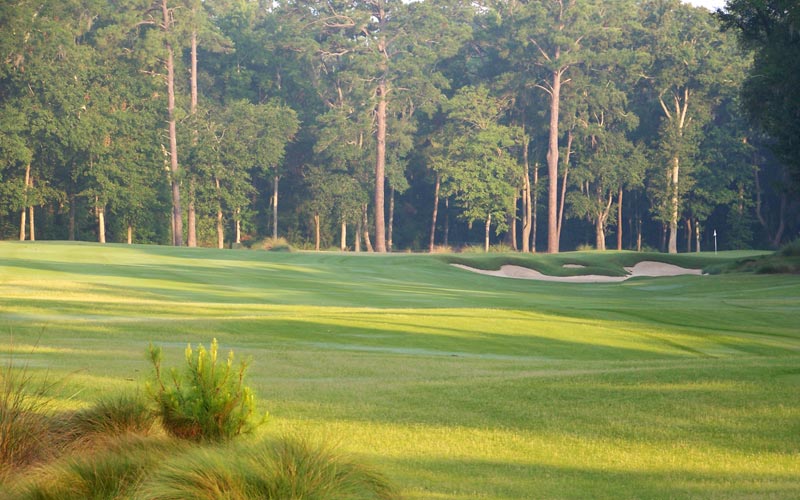
Man’s hand is soft upon the land at May River. Note the absence of artificiality as the first fairway gently bends right around a large fairway bunker.
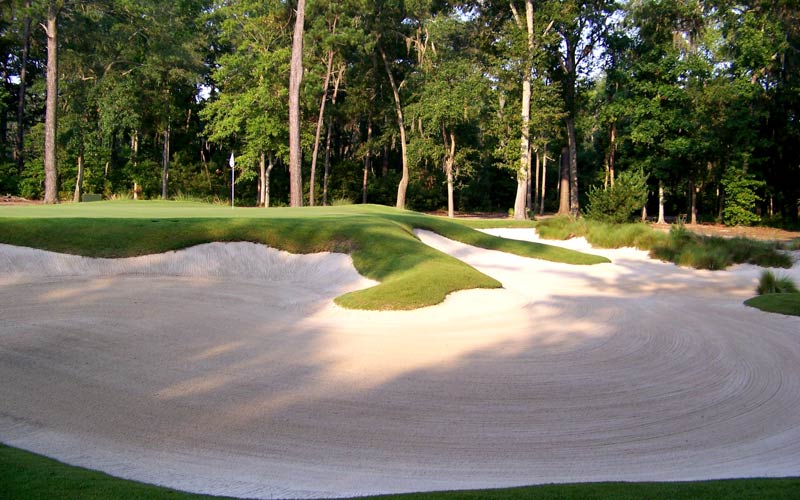
In keeping with its Lowcountry setting, the features at May River hug the ground. That is not to say, though, that the course plays flat. Typical of the rest of the course, the first green appears level with its surrounds when in fact it is pushed up several feet. This view is of the three foot deep bunker that wraps around the back right of the green.
Second hole, 205/185 yards; In the 1970s and 1980s, Nicklaus’s placement of greenside hazards was more confrontational than today. Streams or lakes abutted the edges of greens with but a small margin for error. Over the past two decades, Nicklaus’s design style evolved to a higher level. Take this hole as an example. The wetland was created but it is thirty yards from the front edge of the green. Only a topped shot finds it but it does give the average golfer a sense of accomplishment when he carries it. The large bunker in front of the green is also well off the putting surface. However, the hole is full of playing interest thanks to the qualities of its pushed-up green complex.
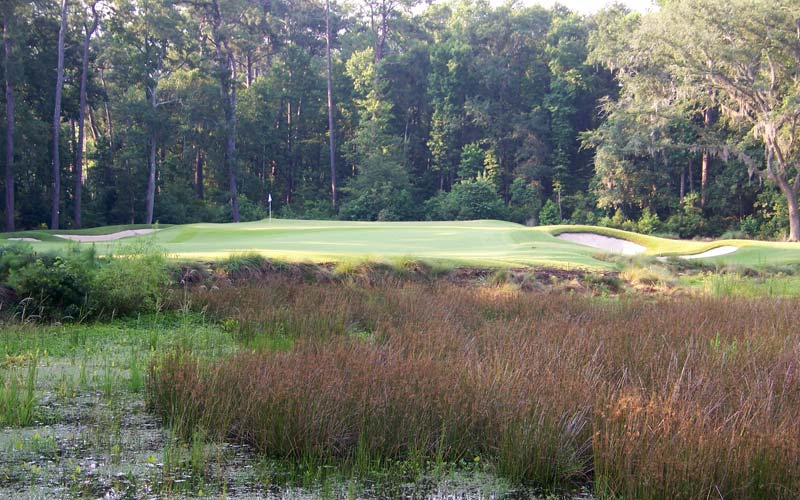
The wetland is really not in play as the putting surface doesn’t start until thirty yards past it. The bunker on the right is also eight paces removed from the front of the green.
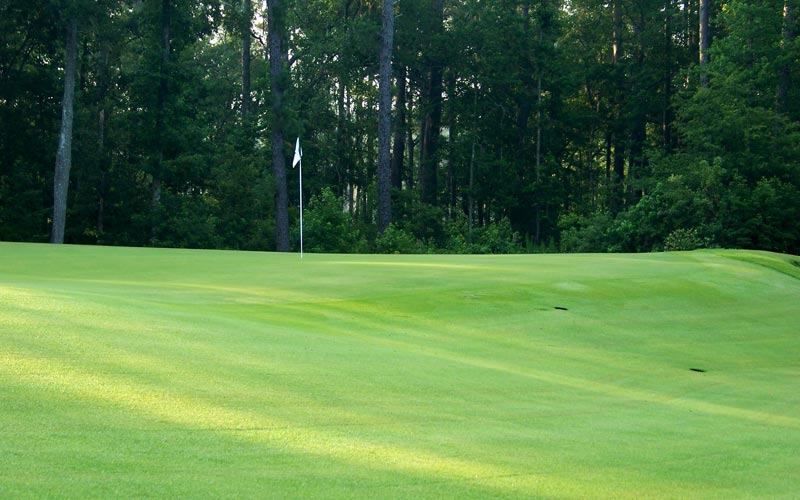
There are more overtly beautiful photographs than this one found within this course profile. However, the photograph above of the right side of the second green illustrates the key role short grass plays in making this an engaging design for all golfers.
Third hole, 430/380 yards; One of the biggest differences in the back and middle markers is found on this hole. For those strong enough to play May River from its 7,170 yard back tees, the lake is the defining factor from the tee. For the remaining ninety-eight percent of us, we will enjoy the course far more from the 6,620 tee markers. The tiger and the nine handicap golfer are both pleased with their respective challenges on this hole.
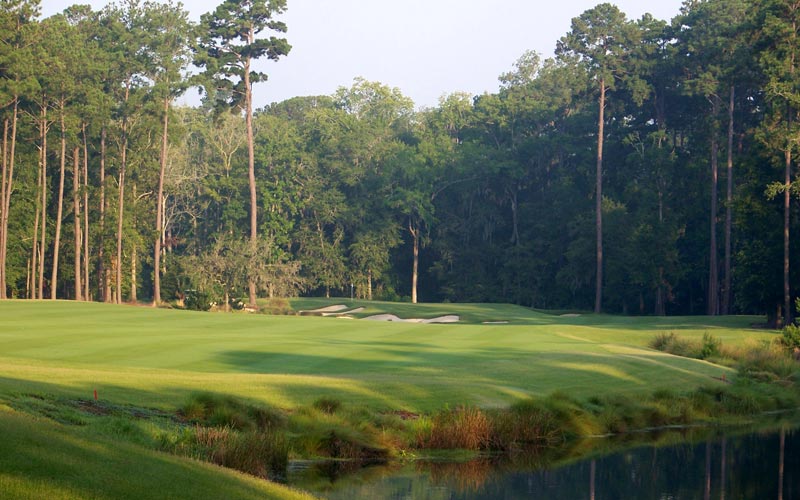
A view from the back markers shows that the skilled golfer needs to challenge the water down the right in order to have the best approach angle into the green. The forward tees are toward the left, making the water less of a factor.

The meticulous tree clearing process uncovered this baby live oak ninety yards from the green. Though there is concern as to how big it will become with time, Nicklaus was insistent it be left.
Fourth hole, 565/535 yards; A strength from the beginning of Jack Nicklaus’s design career has been his ability to create great three shot holes. In particular, there is invariably some form of hazard that one may elect to contend with their second in order to set up a potential birdie. Examples from around the world include carrying the dry wash at the fourth at Cabo del Sol in Mexico and the alternate paths created at the sixth at The Legends Golf and Country Resort in Malaysia. Here, an eighty yard long bunker from 150 to seventy yards short of the green creates all sorts of interesting playing decisions.
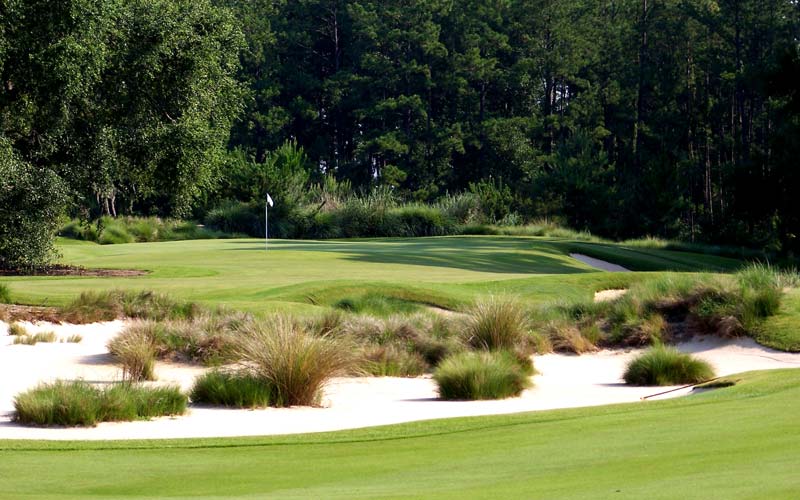
Can the golfer carry this bunker in two? Or should he lay up short of it, directly in line with the fourth flag? Perhaps laying up farther down its right side makes the most sense when the hole location is left?
Fifth hole, 440/420 yards; While all the green complexes at May River are different, none compete among themselves for attention. Rather, when taken as a set, they compliment each other and pose a great variety of challenge. Take this green for instance. Unusual for the course, it is broader (42 yards) than it is deep (21 yards). Thus, the approach to the fifth is more about distance control than direction. Though there are two bunkers across the front, they are small and there is plenty of room to run the ball onto the green. Shots that go long leave a recovery shot from short grass.

Provided the golfer is patient and takes time to learn the course, he finds there is almost always a way to reach even the most difficult hole locations. Take the one above on the left wing of the fifth green. With water ten paces left of the putting surface and a small bunker in front, the golfer is wise to use the high center spine to feed his approach shot left into the bowl and toward the day’s hole location.
Sixthhole, 175/155 yards; One reason why May River is a fun course for all is how Nicklaus handled forced carries. He had to get the golfer across the fifty yard wide Greenleaf Creek and a very fine way to do so was to create a one shotter, thus affording all golfers the luxury of a perfect lie from the tee.
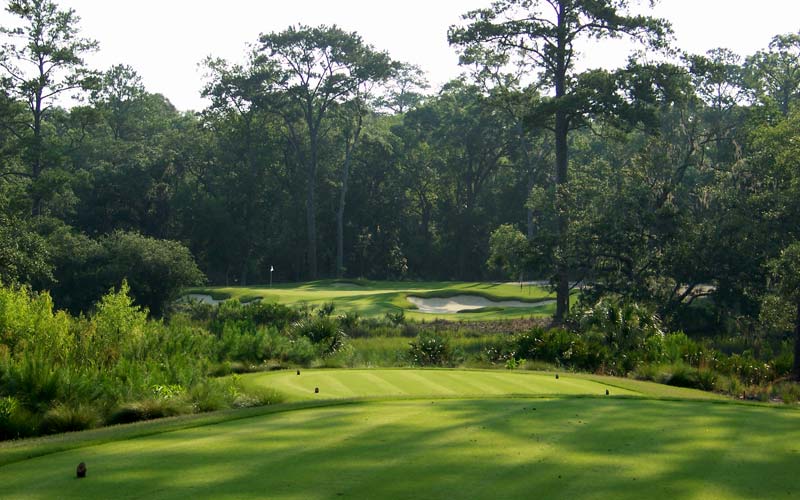
The postcard perfect sixth hole at May River. One of the course’s best hole locations is back left. A depression within the green starts in line with the two tall trees behind the green, and serves to gather balls back toward such hole locations.
Seventh hole, 335/310 yards; One attribute of a great short two shotter is that there be no consensus on how it should best be played. Holes like the twelfth at The Old Course, the ninth at Cypress Point, and the fifth at Crystal Downs have stumped golfers for decades. So too will this little menace. Charlie Kent, Director of Golf, prefers to take his tee ball right, leaving him a 100 to 110 yard shot across the slough to the green. A full pitch is the desired result, as Mr. Kent now has the ability to control/spin the ball into this shallow green. Conversely, Greg Wrobel, Head Golf Professional, shortens the hole by playing left. His tee ball finishes close to the hazard, leaving him a fifty to sixty yard wedge. The benefit as Mr. Wrobel sees it? The ground nearest the hazard is flat and gives him the perfect stance/lie whereas the ground on the right of the fairway actually slopes slightly toward the green. Nicklaus’s own advice on playing the hole? ‘Just because the seventh is a short doesn’t mean it is supposed to be a birdie hole. Patience is required. Don’t be so quick to always go after the flag. Sometimes a twenty foot putt from either left or right of the hole is your best play.’
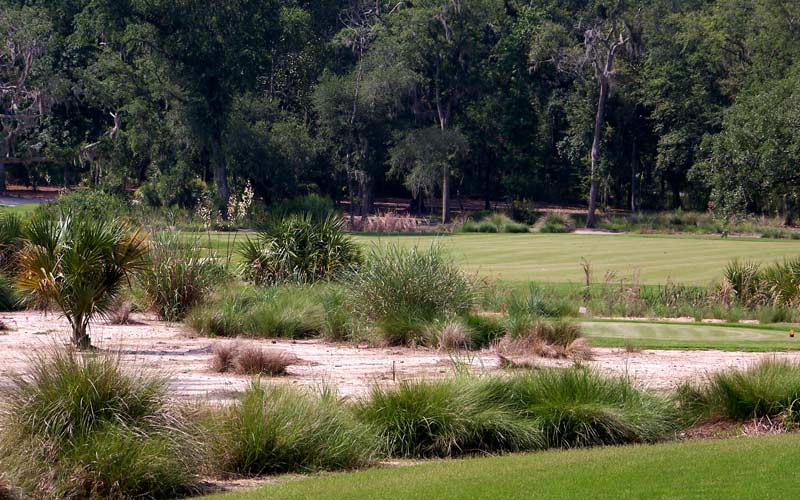
The golfer is greeted with views of expansive playing corridors from most tees at May River. However, the view from the seventh tee is one of the more intimidating on the course. Easily the shortest two shotter on the course, the seventh is the eleventh handicap hole, high for a hole of such modest length.
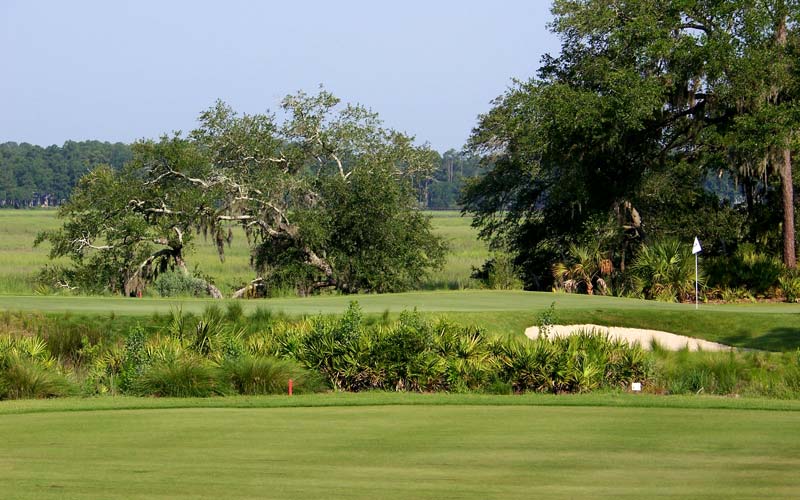
From any angle, the pitch across the slough is to a wide but shallow target. The left of the green narrows to only nine (!) paces. However, the right hole location seen above is just as taxing as the putting surface past the right greenside bunker slopes away from the player.
Eighth hole, 555/535 yards; For the first time at May River, the golfer faces one of the most time honored design elements in golf course architecture, namely a central bunker. Central bunkers force decisions from golfers that otherwise would not need to be made. In this case, if the golfer hopes to reach the green in two, he needs to fit a drive left of the central bunker. Otherwise, for those treating the hole as a three shotter, they may elect a three wood off the tee to take the central bunker out of reach or take the safe – but longer – route down the right. Central bunkers surrounded by nothing but fairway come into play again at the tenth, twelfth, and eighteenth holes, and all the holes are better for it.
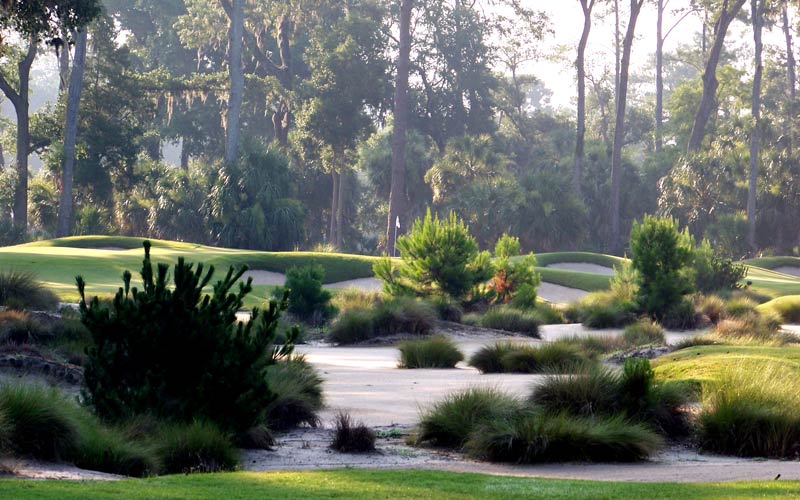
A perfect drive left of the central bunker leaves the thrilling prospect of carrying this long bunker and reaching the eighth green in two.

Most golfers lay up right of the two hundred and fifty yard long bunker, leaving this attractive ninety yard pitch to the green. As seen above, some of the indigenous plants around the creeks and in the bunkers prevent perfect visuals. This welcome feature adds an element of mystery that is uncommon for a flat course.
Ninth hole, 470/445 yards; Golf course design was at a low point from 1955 to 1990 with a primary culprit being how greens were defended. Aerial approach shots were demanded with monotonous regularity as greens were frequently bunkered both left and right. With creativity and shot options snuffed out, the game became boringly one dimensional. How or why this happened remains a mystery. The Old Course at St. Andrews set the standard by being fiercely bunkered in the middle of its enormous greens while lessening its challenge toward the right of the greens. Alister Mackenzie embraced the concept beautifully at Royal Melbourne of having a hazard on one side of the green only. The ninth at May River serves as a ‘how-to’ in building an interesting green complex. The approach is frequently into the wind off the May River and from two hundred yards. Thus, it was paramount that the green accept a running approach shot; otherwise, the hole would overwhelm all but the strongest. Lipe also proudly points out that the interior green contours help feed approach shots to reach hole locations behind the right bunker.
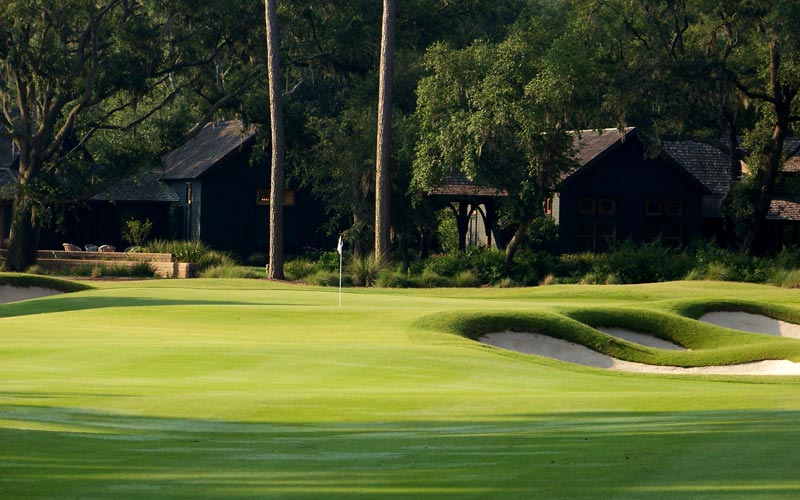
The dark green color of the clubhouse compound was carefully selected to help it meld into the background. The sprawling greenside bunker on the right is the obvious hazard to avoid but that can leave the golfer with…
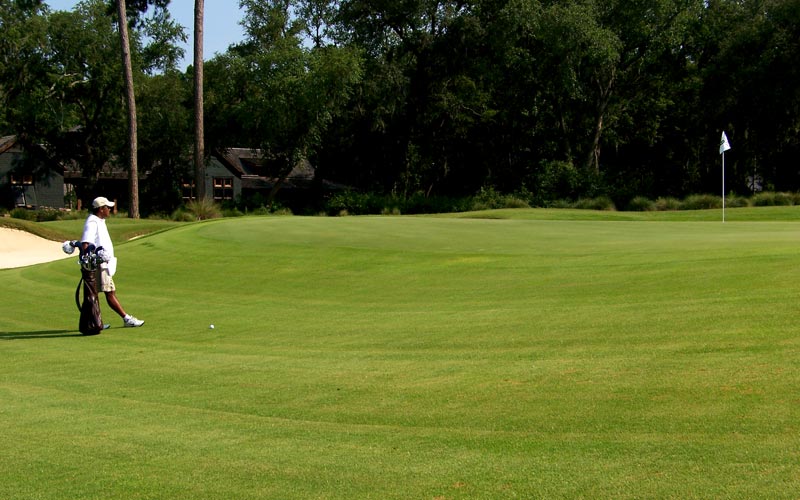
…this ticklish recovery from the left. The short grass in front and to the left of the ninth green allows this long two shotter to play well for all skill sets of golfers.
Tenth hole, 555/520 yards; A host of playing angles make the tenth a special three shotter. According to Lipe, ‘The tee shot for those wanting to play it as a three shot hole is down the left away from the right fairway bunker complex, thus setting up a second shot again left of the large pine. This route leaves a more difficult approach shot into the green, but there is a lot of fairway and it represents the safest par. But, for those with a birdie in mind, the challenge begins on the tee shot. Those that can carry the right bunker gain help as the fairway gathers to the right of the center bunker, thus opening up the green for a running approach shot. The fairway contour also allows for a tee shot to “feed” and run below the central bunker and find that same right portion of the fairway, if carrying the bunker is not possible. In that manner, there are two ways to get to the A position off the tee. Even if the green is unreachable because of wind off the May River, playing short of the green on the right opens up the easiest approach shot/pitch and makes birdies a real possibility. Of course, that approach also brings in the risk of the river on the right. Also, for veterans, when the pin is back left behind theleft greenside bunker, the best play on a second shot could be long left (still fairway) past the bunker and pitch back into the slope. That would be easier than from the front right most of the time. Just another wrinkle depending on the pin location.’ The permutations of things that can happen on this hole make it a love/hate affair. Carry the creek in two and all is well. However, get gummed up in one of the well placed fairway bunkers off the tee and the hole bears its teeth.
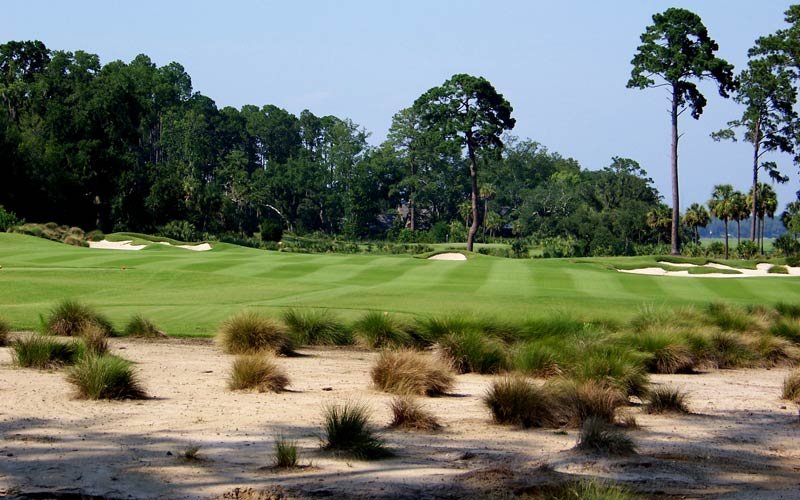
Playing angles galore off the tenth tee. Golfers treating the tenth as a three shotter play left of the central bunker seen in line with the crooked, one hundred year old loblolly pine tree. Golfers wishing to reach the green in two are better served playing right of the central bunker as the green opens up from that angle.
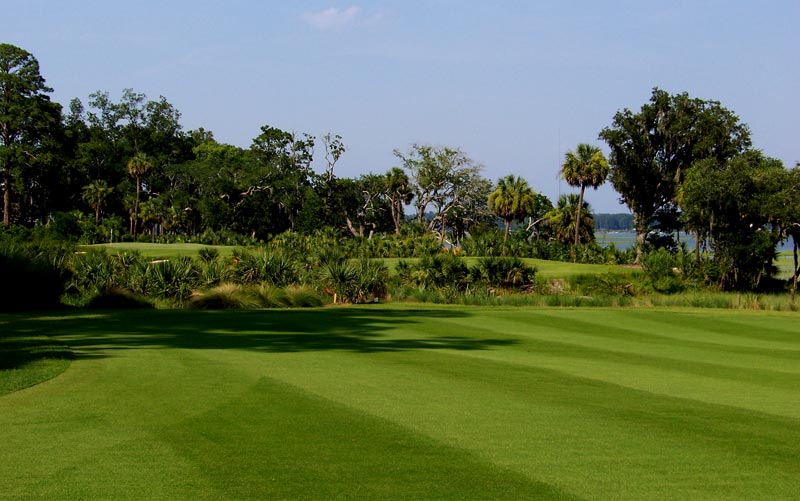
The second shot is intimidating as it calls for a forced carry over a creek that bisects the fairway 150 to 100 yards from the green. The fairway on the far side is only partially visible.
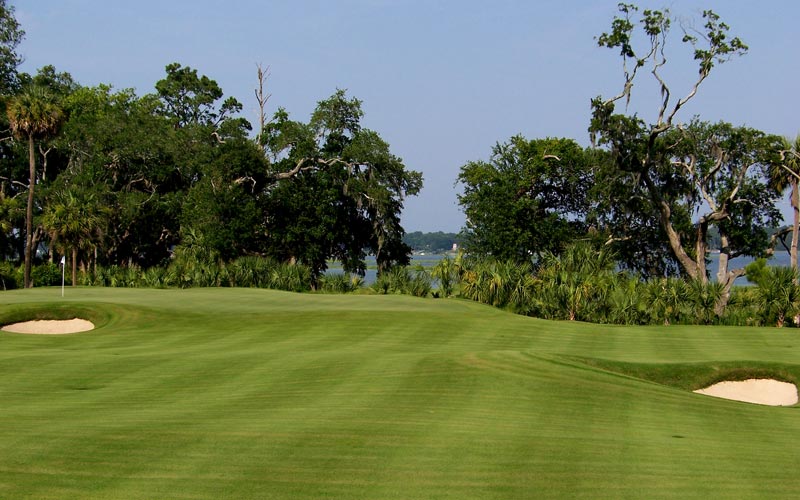
After only a few rounds, the golfer comes to trust the fact that there is plenty of fairway on the far side of the creek. The pushed-up green makes the golfer keen to have only a short iron approach. Also, as is evident above, the approach angle is always better from the right i.e. closer to the hazard.
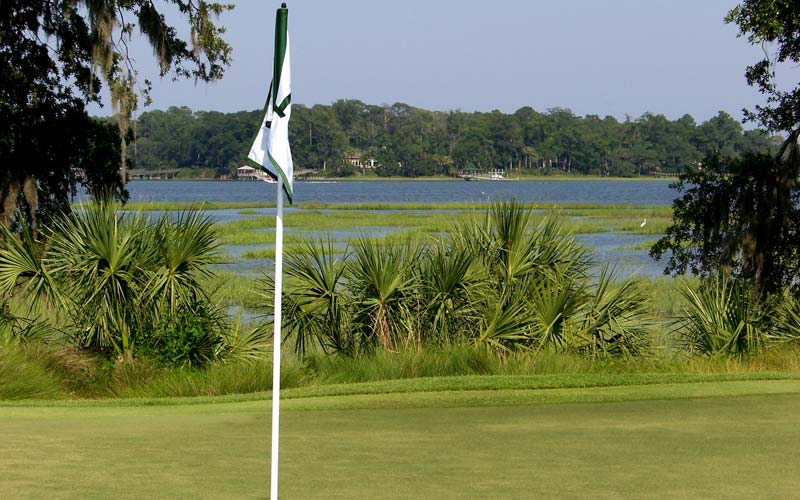
Apart from showing the tenth hole’s beautiful surrounds, the purpose of this photograph is to highlight the tenth green’s close proximity to the May River, which is the windiest spot on the course.
Eleventh hole, 170/145 yards; The long slender green is set at an oblique angle to the lake, calling for a high soft fade. The golfer is near the windiest point on the course (the tenth green) so doubt over the wisdom of a high tee ball crowds in, especially given the depressingly certain fate for any tee ball short or right. Relief comes in two forms. First, the placement of the tees swing out to the left, giving each forward tee a better angle down the length of the course’s longest green. Second, the bunker viewed behind the green is actually fifteen yards behind it, so those that play safely long over the pond have a pitch or putt from a short grass hollow. Thus, the hole actually plays easier than it may first appear. Another attribute of the hole is its flexibility with club selection varing by as much as four clubs depending on the day’s hole location on this forty-nine yard long green.
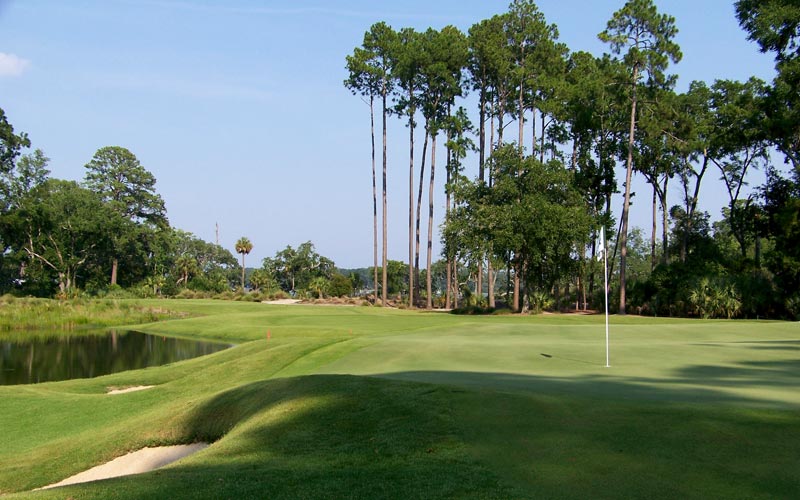
This view from behind the eleventh green highlights the different playing angles from the various markers. The back markers are toward the tall pine in the left of the photograph, creating a tough angle over water to a narrow green. Conversely, the long green is more accessible from the forward tees which are in line with the tallest pines in the middle of the photograph.
Twelfth hole, 400/360 yards; Similar conceptually to the waste bunker at the nearby sixteenth at Harbour Town, the fairway bends left around a230 yard long bunker that runs all the way to the green. In lieu of the dominate tree that dots the fairway at Harbour Town, the Nicklaus design team used a central bunker 130 yards from the green to create indecision as to what club/angle to take from the tee. Bold drives that finish left of the bunker leave the golfer with but a pitch. However, as soon as that central bunker snares the golfer, look for the member to re-evaluate his strategy the very next time he plays the hole. In this manner, the hole and the course stay fresh.
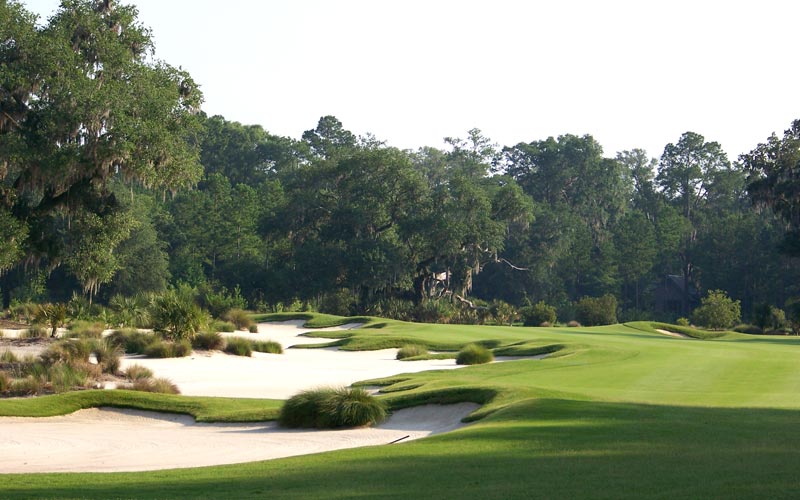
The twelfth fairway gently rises with the central bunker visible to the right on the horizon.
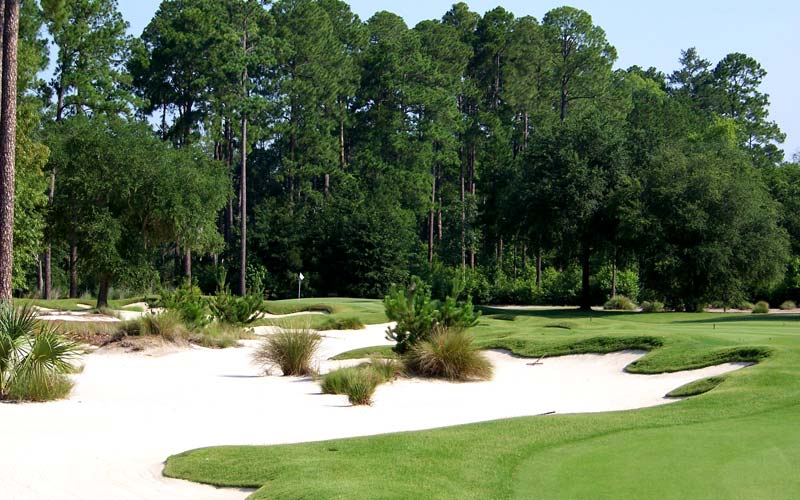
The twelfth green comes into view as one crests the slight incline. An approach from here is a bit left of ideal. The closer one is to the central bunker, the better the view of the green.
Thirteenth hole, 470/410 yards; An effortlessly attractive hole, this two shotter features eight bunkers seemingly strewn in a random manner down the length of the hole. Just like the Club, there is nothing forced or cluttered upon the landscape. One of the prettiest sights on the course is looking back down the fairway in the afternoon.
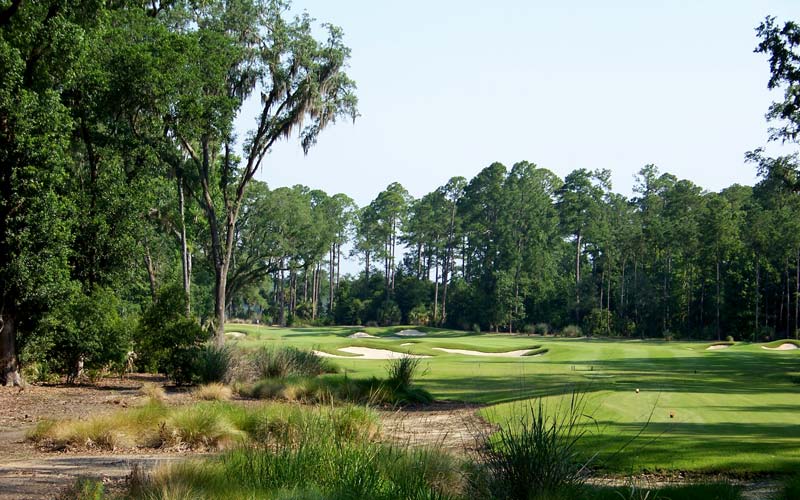
The view from the tee shows how peacefully the free flowing thirteenth rests upon the land.
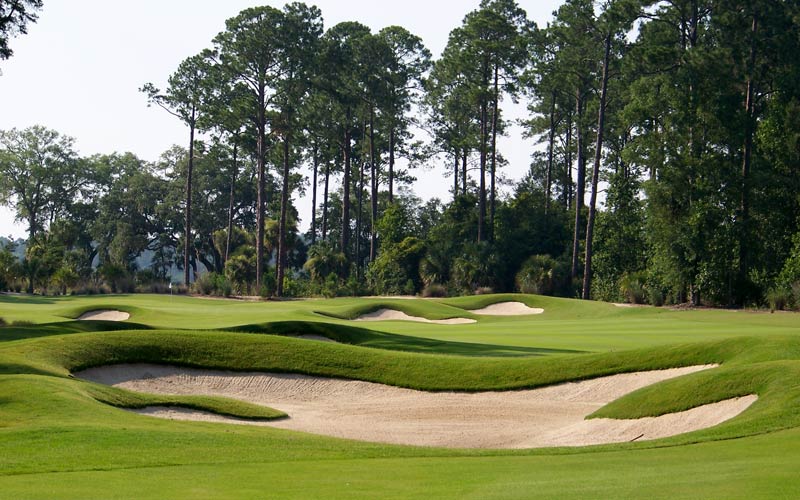
The fairway bunker in the foreground masks the one in the shadows, which is actually the one that is more in play. The wonderful green complex sits in a saddle.
Fourteenth hole, 190/165 yards; This is the most photographed hole on the course, for obvious reasons as it parallels the May River. The temptation is great to take a small bag of balls and spend the day on the tee!
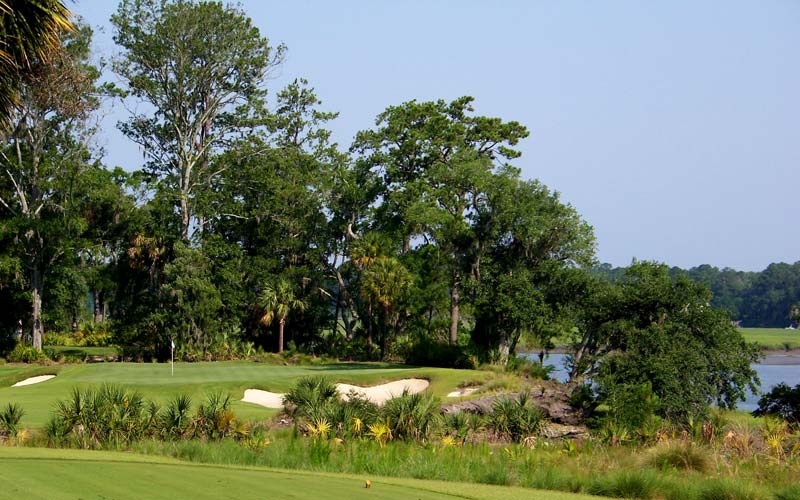
The course brushes up against the May River at the one shot fourteenth. Architecturally, the hole is the best of both worlds, being both visually dramatic while at the same time…

…providing plenty of short grass on the far side of the creek to help the lesser golfer. Please note though that the hazard is on a diagonal and does creep in close…
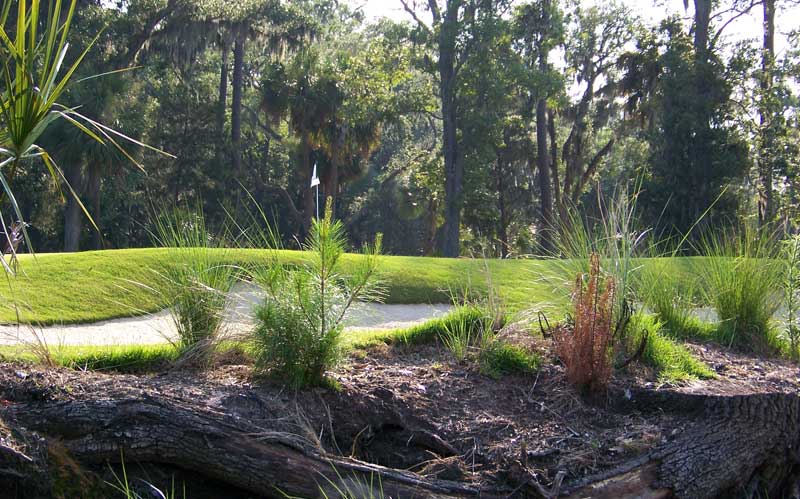
…along the right of the green.
Fifteenth hole, 535/485 yards; In the author’s mind, the quality of the two nines is nearly identical. However, as the back nine consists of three one, two and three shot holes, it is probably (only probably, mind you) the more fun of the two nines to play as a greater mix of events likely occurs. This hole in particular is a most attractive half par hole, thanks to the built up five foot ridge and the accompanying Spectacle bunkers twenty yards short of the green. The sight of one’s approach from 230 yards ball just carrying the crest of the ridge leaves the golfer full of anticipation to the point where he almost feels like running up the fairway to see if he has ashort eagle putt. Providing the golfer with the opportunity to make up lost ground is something not always found in earlier Nicklaus designs – May River is the all better for the give and take between architect and player.
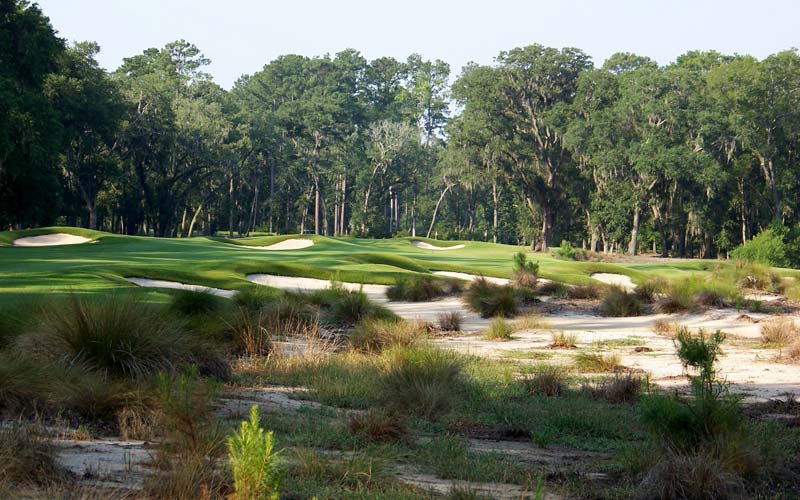
The presentation of May River by Chris Johnson and his crew is in keeping with its rustic Lowcountry setting.
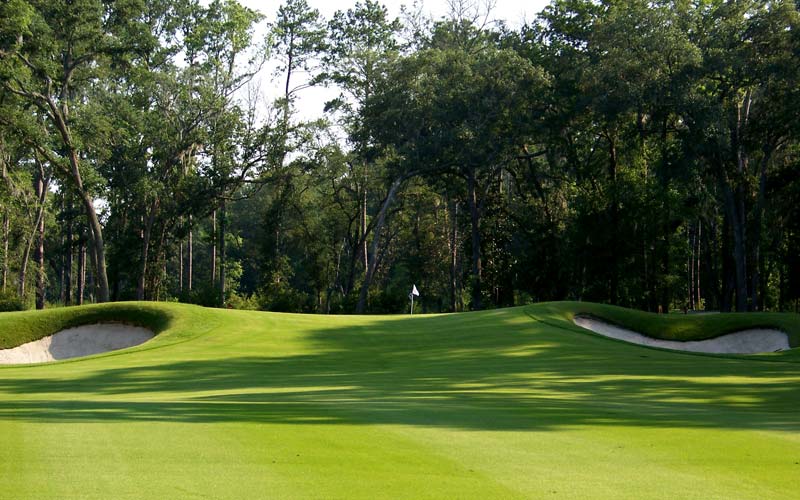
Some of the hit and hope fun of links golf is captured with this modified version of a punchbowl green complex. Be it his second or third shot, the golfer is eager to crest the ridge to see how close his ball lies.
Sixteenth hole, 435/400 yards; Hopefully, the golfer strides to the tee after just conquering the fifteenth. What does he see? A hole in keeping with its peaceful Lowcountry surrounds. There are no water hazards or dramatic landforms to set off warning bells. Why not get greedy? Let’s hit the ball close and get another birdie. What can go wrong?
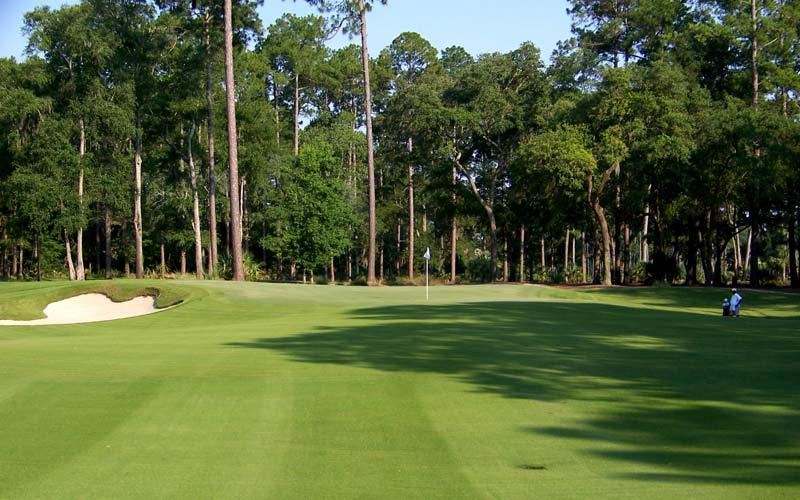
Even as seen from as close as sixty yards, the sixteenth green appears innocuous. However, the height of the caddie tells of the deep grass hollow along the right. The front quarter of the green is only nine paces across and falls away on both sides. Recovery from either side to this forward hole location is vexing. Regardless of the hole location, the prudent approach on this sleeper is for the middle of the green.
Seventeenth hole, 235/215 yards; As highlighted in countless course profiles found within this web site (The Old Course at St. Andrews, The Jockey Club, Yeamans Hall, etc.), having the harder of the last two holes be the penultimate one is a great way to conclude the round. In that manner, the golfer is more likely to finish on an up note, one that leaves him keen to return. Such is the case here with the seventeenth perhaps the toughest target to hit in regulation on the course. The green is among the smaller ones and the left bunker is the deepest greenside bunker on the course at over six feet. The left and right sides of the putting surface are high, so recovering to a short sided hole location is next to impossible. Playing for the front edge of the green often works in the golfer’s favor.

The screws are tightened at the long one shot seventeenth. The sable palms in the background were all there, providing a most handsome backdrop.
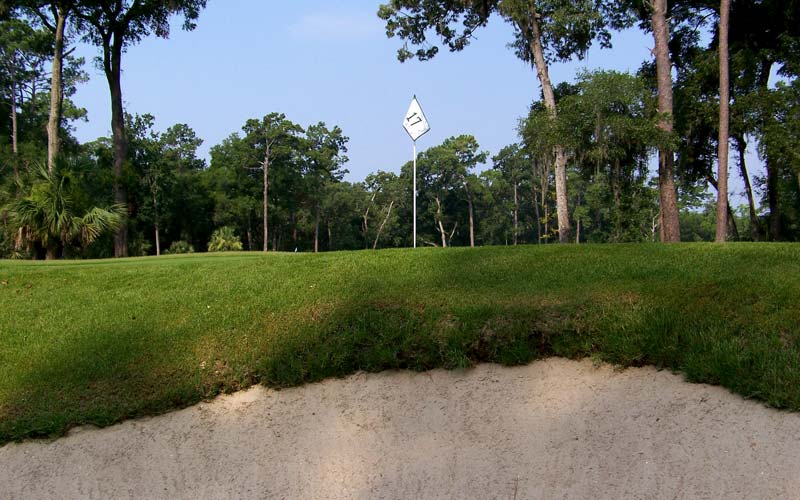
A high soft bunker shot is required if one misses the seventeenth green to the left.
Eighteenth hole, 570/550 yards; Well devised playing angles greet the golfer on the tee one last time. Drive long left near the water and the golfer has the best/only chance of reaching this left to right angled green. Steer too cautiously to the right and a live oak interfers with one’s second shot. Prudently, the live oak was limbed-up to allow a low recovery. One final central bunker complicates matters, perfectly located 110 yards from the green.
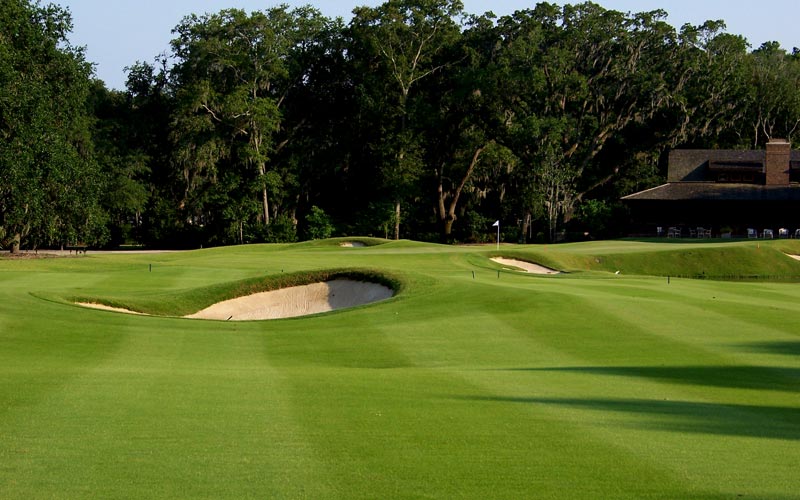
One of the last bunkers built on the course was this central bunker 110 yards from the Home green. Play to the right of it and the water by the green is very much in play and in plain view. Play out left of the bunker and…
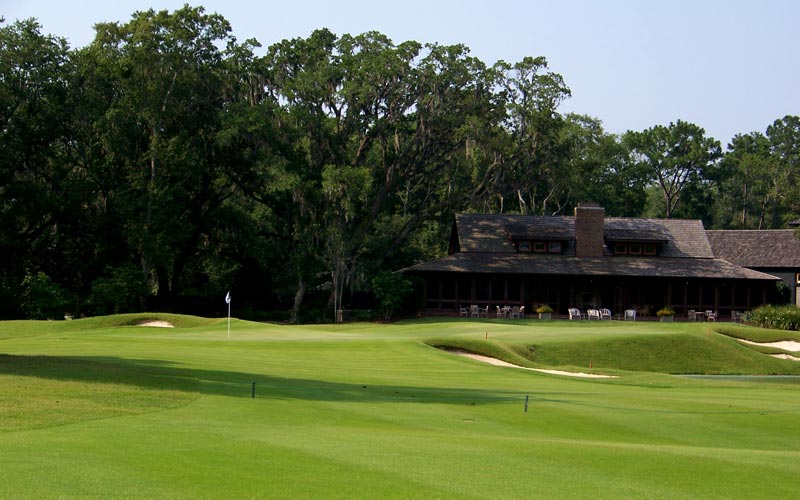
…the golfer enjoys a better angle down the length of the green with the water less in play/view.
The May River Golf Club is found within the 20,000 acres that comprises the Palmetto Bluff Resort. The Nicklaus design team delivered a great golf course with timeless playing qualities as a cornerstone from which this development will grow. Now it is up to Crescent to make the most of the opportunity. Their land plan looks attractive with the homes slated to be well back from the golf course, hidden underneath the canopy of trees. Hopefully, homes will never be built behind the greens or tees and thus ruin the sight lines – this is too good of a golf course to allow that to happen. Further good news is that Coore & Crenshaw may begin construction on a potential second course about eight miles from the Nicklaus one in the 2017 timeframe.
Just as nearby Harbour Town came to symbolize a return to thoughtful golf, May River will always stand very high within the galaxy of Nicklaus designs for striking the perfect balance between challenge and fun. Jack Nicklaus is sixty-seven as of this writing. Just like his win in 1986 in Georgia, it is wonderful to see that he is saving some of his best for last.

May River Golf Club is a private club though guests of the nearby Inn at Palmetto Bluff (www.palmettobluffresort.com) are allowed certain playing privileges. The baby alligator keeps a close eye on play at the third.
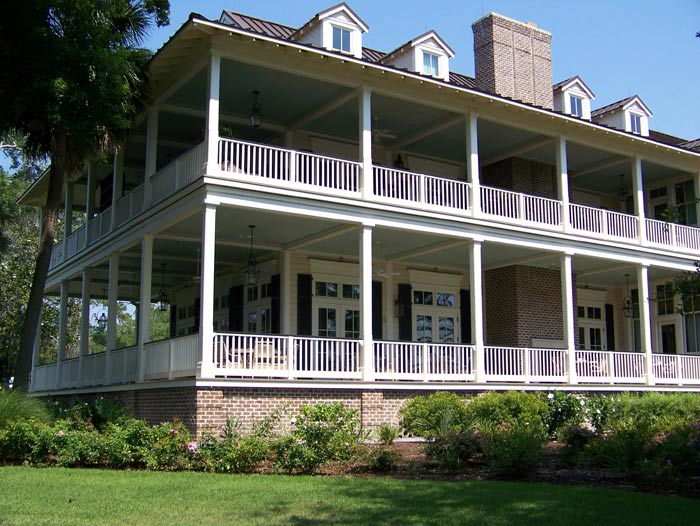
The Inn at Palmetto Bluff is the first luxury property on the east coast for Auberge Resorts (www.aubergeresorts.com). Actually there are no rooms in the Inn itself and guests stay…
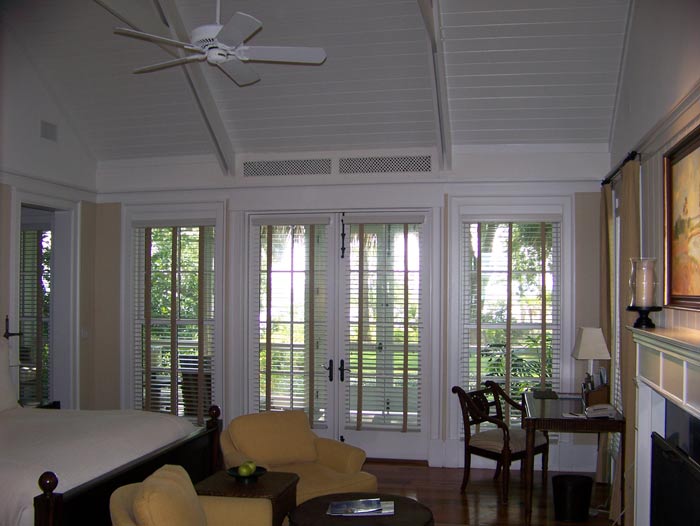
…at one of the fifty cottages and cottage suites that line the bluff or in one of the forty nine village homes.
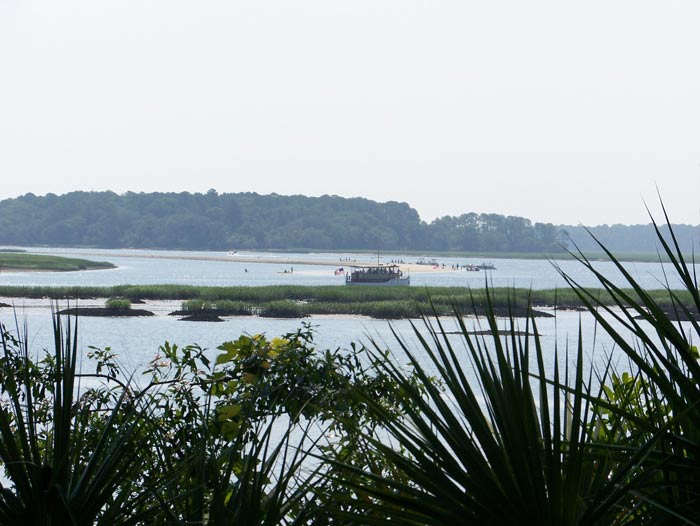
This view from near the Inn shows why it is called Palmetto Bluff. The Grace, a sixty foot antique motor yacht, heads past the sand bar with bathers and out toward Calibogue Sound. A thirty minute complimentary water taxi service is provided from the Inn to Harbour Town and its famous red and white lighthouse.
The End

